INSTITUT SUPERIEUR D'ANTHROPOLOGIE
INSTITUTE OF ANTHROPOLOGY
ONLINE COURSES / COURS A DISTANCE
SPRING TERM : APRIL 2015
REGISTER NOW
ESPAGNE – 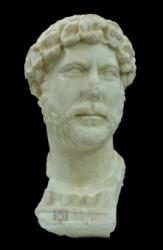 Los Torrejones - A marble bust of Hadrian, excavated at the archaeological site of Los Torrejones, in Murcia, Spain, will be exhibited at the local museum, the Museo Arqueológico de Yecla. The bust, discovered at the site in an excavation that took place from October to December 2014 and is in excellent condition, depicting Hadrian with a beard and curly hair, slightly tilting his head to the left. It belongs, as it seems, to the Rollockenfrisur type, one of the six sculptural types attributed to the emperor. Other statues of this type include statues in the Israel Museum, the Prado in Madrid, the British Museum, and the Uffizi Gallery in Florence. The statue is 52 cm high, carved out of white marble and is thought to date to 135 AD. It was found next to another, smaller, figure of the same period, depicting a woman. They were both at the entrance of a large building, but the purpose of the edifice has not yet been defined. It could have been a Nymphaeum, but it could also have been linked to the worship of the Emperor. The site consists of a Roman villa complex including a residential area and an area reserved for servants and workers on the farm. It is one of the five sites discovered in the region that date from the period 1st-4th centuried AD.The excavations will probably be resumed in 2015.
Los Torrejones - A marble bust of Hadrian, excavated at the archaeological site of Los Torrejones, in Murcia, Spain, will be exhibited at the local museum, the Museo Arqueológico de Yecla. The bust, discovered at the site in an excavation that took place from October to December 2014 and is in excellent condition, depicting Hadrian with a beard and curly hair, slightly tilting his head to the left. It belongs, as it seems, to the Rollockenfrisur type, one of the six sculptural types attributed to the emperor. Other statues of this type include statues in the Israel Museum, the Prado in Madrid, the British Museum, and the Uffizi Gallery in Florence. The statue is 52 cm high, carved out of white marble and is thought to date to 135 AD. It was found next to another, smaller, figure of the same period, depicting a woman. They were both at the entrance of a large building, but the purpose of the edifice has not yet been defined. It could have been a Nymphaeum, but it could also have been linked to the worship of the Emperor. The site consists of a Roman villa complex including a residential area and an area reserved for servants and workers on the farm. It is one of the five sites discovered in the region that date from the period 1st-4th centuried AD.The excavations will probably be resumed in 2015.
http://www.archaeology.wiki/blog/2015/02/09/marble-bust-hadrian-unearthed/
GRECE – 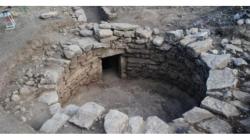 Amfissa - An ancient Greek Mycenaean tomb was unearthed in Amfissa, central Greece, during an irrigation project that required excavation in the area. It is a unique finding, the first of its kind that has ever been found in West Locris and one of the few in central Greece. The preliminary archaeological study of the findings shows that the tomb was used for more than two centuries, from the 13th to the 11th century B.C.. Within the burial chamber archaeologists found a large amount of skeletal material, which had accumulated near the surrounding walls, while a few better preserved burials were also uncovered. Furthermore, the excavation revealed forty-four vases with painted decorations, the two bronze fragmented vases, as well as gold rings, brass buttons, fragments of semi precious stones, two bronze daggers, female and animal figurines, and a large number of seals with animal, plant and linear patterns. The full scientific research regarding the recent finding will be made by a team of archaeologists and it is expected to provide new information about the archaeological and historical development of the region.
Amfissa - An ancient Greek Mycenaean tomb was unearthed in Amfissa, central Greece, during an irrigation project that required excavation in the area. It is a unique finding, the first of its kind that has ever been found in West Locris and one of the few in central Greece. The preliminary archaeological study of the findings shows that the tomb was used for more than two centuries, from the 13th to the 11th century B.C.. Within the burial chamber archaeologists found a large amount of skeletal material, which had accumulated near the surrounding walls, while a few better preserved burials were also uncovered. Furthermore, the excavation revealed forty-four vases with painted decorations, the two bronze fragmented vases, as well as gold rings, brass buttons, fragments of semi precious stones, two bronze daggers, female and animal figurines, and a large number of seals with animal, plant and linear patterns. The full scientific research regarding the recent finding will be made by a team of archaeologists and it is expected to provide new information about the archaeological and historical development of the region.
http://greece.greekreporter.com/2015/02/07/untouched-mycenaean-tomb-found-in-central-greece/
ROYAUME UNI – 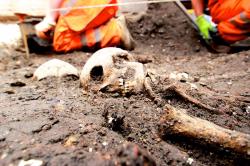 Londres - During the construction of the Crossrail station at Liverpool Street, 3,000 skeletons were discovered in a former burial pit in the grounds of Bedlam hospital. New research means we may be able to put names to the former patients of the notorious institution whose name is synonymous with "madness". A Crossrail research project has revealed the names and backgrounds of over 5,000 Londoners interred in the burial ground. In June last year Crossrail invited 16 volunteers to scour parish records from across the capital to create the first extensive list of people buried at Bedlam in the 16th and 17th centuries. The resulting database, published today (9 February), sheds light on a tumultuous period of London's history. According to the research Dr John Lamb (also known as Lam or Lambe), an astrologer and advisor to the First Duke of Buckingham, is among those buried at the site. Lamb was said to have been stoned to death by an angry mob outside a theatre in 1628 following allegations of rape and black magic. Others identified in the study include Sir Ambrose Nicholas, Lord Mayor of London in 1575 and victims of riots by 'Fanatiques,' noted in the diaries of Samuel Pepys in January 1661. Plague was the most common listed form of death, followed by infant mortality and consumption. The burial ground was established in 1569 to help parishes cope with overcrowding during outbreaks of plague and other epidemics. Crossrail workers recently discovered the gravestone of Mary Godfree who died in September 1665, as a result of the 'Great Plague' which peaked that year. Jay Carver, lead archaeologist at Crossrail, said: "This research is a window into one of the most turbulent periods of London's past. These people lived through civil wars, the Restoration, Shakespeare's plays, the birth of modern industry, plague and the Great Fire. It is a real privilege to be able to use Europe's largest construction project to uncover more knowledge about this fascinating period of history." The archaeological excavations at Liverpool Street are undertaken by MOLA (Museum of London Archaeology) on behalf of Crossrail. Scientific analysis of up to 3,000 skeletons will provide new insights into the lives and deaths of early modern Londoners. The upcoming dig is also expected to uncover medieval and Roman artefacts and help piece together centuries of history. After excavation the skeletons will be reburied on consecrated ground. To date Crossrail has found more than 10,000 artefacts spanning 55 million years of London's history across over 40 construction sites.
Londres - During the construction of the Crossrail station at Liverpool Street, 3,000 skeletons were discovered in a former burial pit in the grounds of Bedlam hospital. New research means we may be able to put names to the former patients of the notorious institution whose name is synonymous with "madness". A Crossrail research project has revealed the names and backgrounds of over 5,000 Londoners interred in the burial ground. In June last year Crossrail invited 16 volunteers to scour parish records from across the capital to create the first extensive list of people buried at Bedlam in the 16th and 17th centuries. The resulting database, published today (9 February), sheds light on a tumultuous period of London's history. According to the research Dr John Lamb (also known as Lam or Lambe), an astrologer and advisor to the First Duke of Buckingham, is among those buried at the site. Lamb was said to have been stoned to death by an angry mob outside a theatre in 1628 following allegations of rape and black magic. Others identified in the study include Sir Ambrose Nicholas, Lord Mayor of London in 1575 and victims of riots by 'Fanatiques,' noted in the diaries of Samuel Pepys in January 1661. Plague was the most common listed form of death, followed by infant mortality and consumption. The burial ground was established in 1569 to help parishes cope with overcrowding during outbreaks of plague and other epidemics. Crossrail workers recently discovered the gravestone of Mary Godfree who died in September 1665, as a result of the 'Great Plague' which peaked that year. Jay Carver, lead archaeologist at Crossrail, said: "This research is a window into one of the most turbulent periods of London's past. These people lived through civil wars, the Restoration, Shakespeare's plays, the birth of modern industry, plague and the Great Fire. It is a real privilege to be able to use Europe's largest construction project to uncover more knowledge about this fascinating period of history." The archaeological excavations at Liverpool Street are undertaken by MOLA (Museum of London Archaeology) on behalf of Crossrail. Scientific analysis of up to 3,000 skeletons will provide new insights into the lives and deaths of early modern Londoners. The upcoming dig is also expected to uncover medieval and Roman artefacts and help piece together centuries of history. After excavation the skeletons will be reburied on consecrated ground. To date Crossrail has found more than 10,000 artefacts spanning 55 million years of London's history across over 40 construction sites.
https://uk.news.yahoo.com/crossrail-project-aims-identify-3-000-skeletons-former-101713748.html#q6ZM6vA
FRANCE – 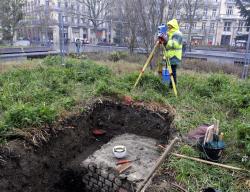 Toulouse - Un magnifique morceau du rempart antique de Tolosa (Ier siècle) a été découvert hier au square Charles de Gaulle. Avant que les jardiniers n'entrent en jeu, les archéologues ont sondé le sol du square qui avait fait l'objet de fouilles préventives avant les travaux de rénovation. C'est en effectuant ces sondages, à l'endroit où il était prévu de planter les nouveaux cèdres, qu'un bout du rempart gallo-romain a été trouvé. Cette muraille vieille de 2000 ans était enfouie sous le parterre central, non loin du donjon du Capitole. «Notre première surprise a été de trouver ces vestiges à seulement cinquante centimètres de profondeur, car dans d'autres endroits de la ville, comme aux Carmes ils sont beaucoup plus profonds», confie Pierre Pisani, responsable du service archéologique de Toulouse Métropole. «L'autre bonne surprise, c'est qu'en creusant on a mis au jour une paroi remarquablement bien conservée, sur 1,50 m de largeur et 2,40 m de longueur. On sent le côté monumental de l'ouvrage qui devait faire 7 à 8 mètres de haut. C'est toujours émouvant de voir les techniques de construction aussi bien conservées. Il est comme neuf !». Les archéologues sont formels, ce pan de muraille en briques, moellons et galets de Garonne est incontestablement un vestige du rempart antique qui a été construit au Ier siècle sous l'empire romain pour encercler Toulouse. Cette fortification dotée de plusieurs tours entourait la ville, qui était déjà à l'époque romaine une grande agglomération d'une trentaine d'hectares. «On sait que le rempart de Toulouse passait dans ce coin, car lors des travaux de rénovation du square Charles de Gaulle il y a deux ans on a mis au jour la fondation d'une des tours, la tour Charlemagne, ancienne prison de la ville» confirme Pierre Pisani. «On avait aussi trouvé des morceaux lors de la construction du métro. Aujourd'hui, cette découverte nous permet de préciser le tracé du mur d'enceinte». Un vestige d'une tour du rempart gallo-romain est conservé au sous-sol du TNT, près du bar du théâtre. Un autre morceau de la muraille est visible sur le parking de la place Saint-Jacques, derrière la Préfecture.
Toulouse - Un magnifique morceau du rempart antique de Tolosa (Ier siècle) a été découvert hier au square Charles de Gaulle. Avant que les jardiniers n'entrent en jeu, les archéologues ont sondé le sol du square qui avait fait l'objet de fouilles préventives avant les travaux de rénovation. C'est en effectuant ces sondages, à l'endroit où il était prévu de planter les nouveaux cèdres, qu'un bout du rempart gallo-romain a été trouvé. Cette muraille vieille de 2000 ans était enfouie sous le parterre central, non loin du donjon du Capitole. «Notre première surprise a été de trouver ces vestiges à seulement cinquante centimètres de profondeur, car dans d'autres endroits de la ville, comme aux Carmes ils sont beaucoup plus profonds», confie Pierre Pisani, responsable du service archéologique de Toulouse Métropole. «L'autre bonne surprise, c'est qu'en creusant on a mis au jour une paroi remarquablement bien conservée, sur 1,50 m de largeur et 2,40 m de longueur. On sent le côté monumental de l'ouvrage qui devait faire 7 à 8 mètres de haut. C'est toujours émouvant de voir les techniques de construction aussi bien conservées. Il est comme neuf !». Les archéologues sont formels, ce pan de muraille en briques, moellons et galets de Garonne est incontestablement un vestige du rempart antique qui a été construit au Ier siècle sous l'empire romain pour encercler Toulouse. Cette fortification dotée de plusieurs tours entourait la ville, qui était déjà à l'époque romaine une grande agglomération d'une trentaine d'hectares. «On sait que le rempart de Toulouse passait dans ce coin, car lors des travaux de rénovation du square Charles de Gaulle il y a deux ans on a mis au jour la fondation d'une des tours, la tour Charlemagne, ancienne prison de la ville» confirme Pierre Pisani. «On avait aussi trouvé des morceaux lors de la construction du métro. Aujourd'hui, cette découverte nous permet de préciser le tracé du mur d'enceinte». Un vestige d'une tour du rempart gallo-romain est conservé au sous-sol du TNT, près du bar du théâtre. Un autre morceau de la muraille est visible sur le parking de la place Saint-Jacques, derrière la Préfecture.
http://www.ladepeche.fr/article/2015/02/07/2045369-sous-cedres-square-gaulle-bout-rempart-comme-neuf.html
ROYAUME UNI – 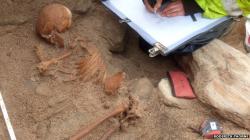 Orkney - Archaeologists have been excavating the site of a child's grave on an Orkney island. The grave - which it is believed could be up to 4,000 years old - was uncovered on Sanday's shoreline by winter storms and high tides. It is thought the skeleton could be that of a child aged between 10 and 12. The find was made by Carrie Brown, of See Orkney tours, who called in local archaeologists. Historic Scotland was alerted, and experts were sent to Sanday on Saturday. The skeleton will be analysed by an osteoarchaeology team in more suitable climatic conditions.
Orkney - Archaeologists have been excavating the site of a child's grave on an Orkney island. The grave - which it is believed could be up to 4,000 years old - was uncovered on Sanday's shoreline by winter storms and high tides. It is thought the skeleton could be that of a child aged between 10 and 12. The find was made by Carrie Brown, of See Orkney tours, who called in local archaeologists. Historic Scotland was alerted, and experts were sent to Sanday on Saturday. The skeleton will be analysed by an osteoarchaeology team in more suitable climatic conditions.
http://www.bbc.com/news/uk-scotland-north-east-orkney-shetland-31313519?
EGYPTE –  Gizeh - The pyramid of Menkaure, the smallest of the three at the Giza Necropolis, is now open to the public after renovation works were completed. The reopening of the 4,300-year-old pyramid is part of a bigger project of the Antiquities Ministry, according to which every one or two years a pyramid will be closed for cleaning and renovation works while the other two will remain open to the public. As the Antiquities Minister Mamdouh al-Damaty stated, the Pyramid of Khafre will be closed on April 1. The pyramid had an original height of 65.5 meters high with a square base of 108.5 meters. The limestone and granite pyramid was built to serve as the tomb of the fourth dynasty Pharaoh Menkaure (2530 BC-2500 BC). Unlike the other two pyramids, in the outer bottom level and the burial chamber of Menkaure’s pyramid pink granite was used that is still visible. Head of Giza archaeological site Kamal Waheed told The Cairo Post that the restoration work included the removal of graffiti which visitors had left on the walls of the pyramid’s passageways and burial chamber, the removal of the salt deposits from its walls and the replacement of the outer stairs leading to the Pyramid. “It also included the installation of a special lighting system which does not damage the drawings and inscriptions while at the same time providing a clear view for visitors,” he added.
Gizeh - The pyramid of Menkaure, the smallest of the three at the Giza Necropolis, is now open to the public after renovation works were completed. The reopening of the 4,300-year-old pyramid is part of a bigger project of the Antiquities Ministry, according to which every one or two years a pyramid will be closed for cleaning and renovation works while the other two will remain open to the public. As the Antiquities Minister Mamdouh al-Damaty stated, the Pyramid of Khafre will be closed on April 1. The pyramid had an original height of 65.5 meters high with a square base of 108.5 meters. The limestone and granite pyramid was built to serve as the tomb of the fourth dynasty Pharaoh Menkaure (2530 BC-2500 BC). Unlike the other two pyramids, in the outer bottom level and the burial chamber of Menkaure’s pyramid pink granite was used that is still visible. Head of Giza archaeological site Kamal Waheed told The Cairo Post that the restoration work included the removal of graffiti which visitors had left on the walls of the pyramid’s passageways and burial chamber, the removal of the salt deposits from its walls and the replacement of the outer stairs leading to the Pyramid. “It also included the installation of a special lighting system which does not damage the drawings and inscriptions while at the same time providing a clear view for visitors,” he added.
http://www.archaeology.wiki/blog/2015/02/09/menkaure-pyramid-open-public/
EGYPTE – 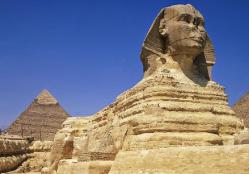 Gizeh - The sphinx is in danger, archaeologist Amir Gamal told Al-Masry Al-Youm on Sunday, as subterranean water in the area has reached the body of the sculpture. “You can see green grass just 50 meters away from it,” Gamal said, explaining that the limestone of which the sphinx is made has a high percentage of calcium in it. “Add to that the sewage problem that officials are not addressing." Gamal said birds enjoy calcium, which is why many of them are seen perched on the sphinx. “Their waste eats away at the body of the sphinx,” he said. “It will be a serious problem when the perforations [on the body of the sphinx caused by the acidic waste] widen with time.”
Gizeh - The sphinx is in danger, archaeologist Amir Gamal told Al-Masry Al-Youm on Sunday, as subterranean water in the area has reached the body of the sculpture. “You can see green grass just 50 meters away from it,” Gamal said, explaining that the limestone of which the sphinx is made has a high percentage of calcium in it. “Add to that the sewage problem that officials are not addressing." Gamal said birds enjoy calcium, which is why many of them are seen perched on the sphinx. “Their waste eats away at the body of the sphinx,” he said. “It will be a serious problem when the perforations [on the body of the sphinx caused by the acidic waste] widen with time.”
http://www.egyptindependent.com/
ITALIE – 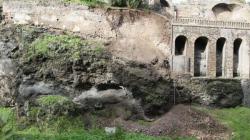 Pompéi - Heavy rain in Italy caused a wall in the ancient city of Pompeii to fall down, the latest in a series of weather-related collapses at the country’s most celebrated archaeological site. The wall in the Garden of Severus suffered a partial collapse after days of rainfall in southern Italy.
Pompéi - Heavy rain in Italy caused a wall in the ancient city of Pompeii to fall down, the latest in a series of weather-related collapses at the country’s most celebrated archaeological site. The wall in the Garden of Severus suffered a partial collapse after days of rainfall in southern Italy.
http://www.thelocal.it/20150205/pompeii-wall-collapses-amid-heavy-rain